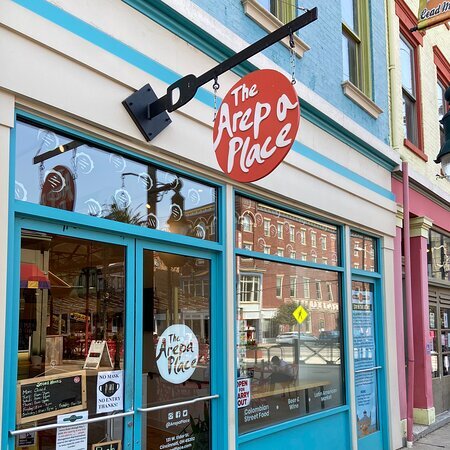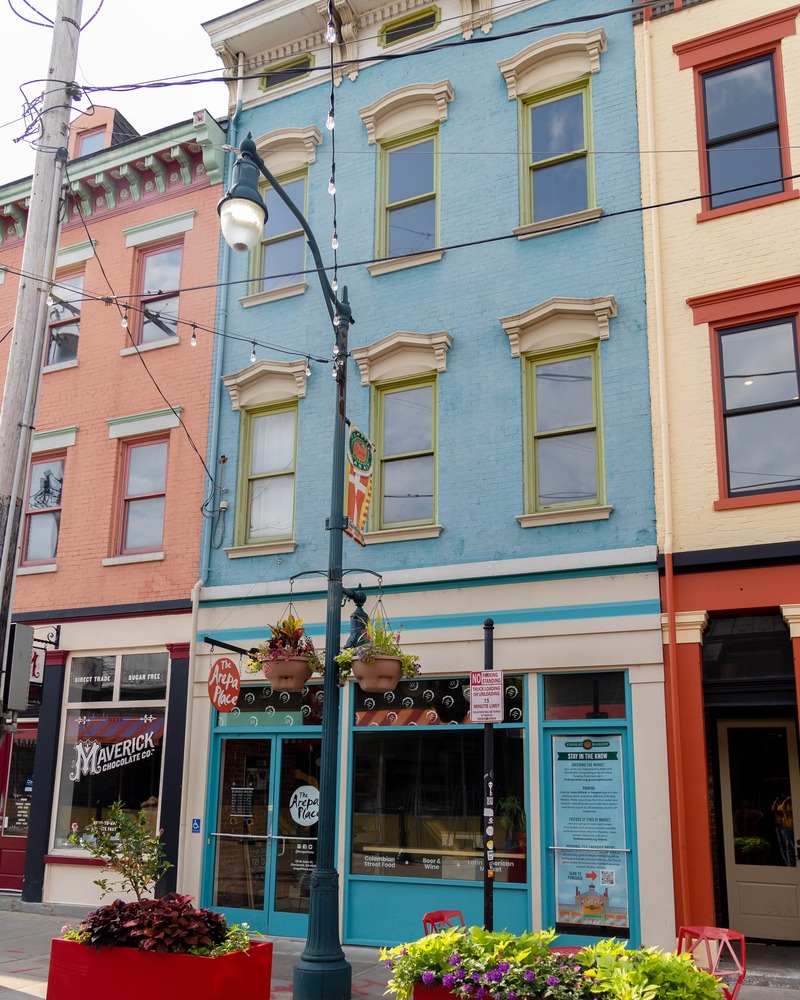
Source: Google Images Date: 2022
Early Years of 131 W. Elder
131 W. Elder—originally listed as 67 Elder—first appeared in city directories in 1862. William Bentel’s coffee house provided some of the first listed commercial activity, as did Joseph Schueler’s cabinetry business.
Joseph (1837-1909), born in 1837 in Hesse-Darmstadt, ran his furniture store out of different buildings along Findlay Market in the 1860s, including at 67, 69 and 71 Elder (131-135 W. Elder). He served in the Civil War in the Union Army as a Private in Company B of the 28th Ohio Volunteer Infantry—an all-German unit led by biergarten owner Augustus Moor.
First organized in May of 1861, the 28th formed largely from recruitment at German meeting halls in Over-the-Rhine. After his service, Joseph returned home and resumed his business at 69 Elder. A German Catholic and a carpenter and cabinet maker by trade, he immigrated to the U.S. in 1853. His wife Magdalena came to the U.S. in 1864. Together, they parented at least six children (four of whom lived beyond childhood).
Like other early tenants of the building, Joseph ran his business from the first floor while he and Magdalena raised their children upstairs, living alongside other families, of course. By the mid-1860s, baker Charles Sabin (1832-1897) ran his operation out of 67 Elder.
A wealthy man—he commanded $25,000 in personal and real estate in 1870 (around half a million dollars today)—he was a German immigrant from Prussia. His first wife Maria (Wolf) was from Bavaria; together they had several children, including Theodore, Minna and Charles, among others who perished young.
His second wife was Bernadina, with whom he had more children, including Clara and Paulina. Charles accumulated several properties in his life, including land on Betts Street, Race Street, Marshall Street and on Carthage Pike.
Jacob Theobald was another baker who worked out of 67 Elder (and out of 65 Elder or 129 W. Elder) in the 1860s.
The Siegmann Family Shoes Business
Beginning in the 1870s, August Siegmann (1834-1885) established a boots and shoes store at 67 Elder. A shoemaker by trade, he had previously worked out of 57 Elder in the 1860s, moving his business to 67 Elder in 1869.
Born near Hannover in 1834, August was a German Catholic immigrant. He and his Bavarian wife Elizabeth (Sauer) (1830-1915) raised their family at 67 Elder. They had several children, but many died extremely young.
As this expansive family lived upstairs in 67 Elder, other families lived alongside them. In the early 1880s, for instance, both the Reddick (or Rettig) and Fichen families resided there with the Siegmanns—many of them cobblers as well—resulting in twenty people inside the building.
As he sold and repaired shoes out of Findlay Market, August purchased real estate as many other early German immigrants in Over-the-Rhine did.
In the spring of 1885, August succumbed to pneumonia and passed away at home. Thereafter, his widow took over the business for the rest of the 1880s. In her older years, she moved in with her children and passed away of a stroke in 1915.
Turn of the 20th Century at 131 W. Elder
After the Siegmann family left 131 W. Elder, John Eger continued its tradition briefly with his boots and shoes store there in the early 1890s. Thereafter, in the last years of the 19th century and the first of the 20th, Henry Geisler (1861-1930)—the largest cheese dealer in Over-the-Rhine—owned 131 W. Elder and occupied the storefront. City directories advertised his business as a “Dealer in all kinds of Cheese and Delicacies, Domestic and Imported Sardines, French Mustard Etc.”
Born just before Christmas in 1861 in Marburg, Germany, Henry immigrated to the U.S. in 1881 via Antwerp, Belgium. Two years later, he wed. He and his wife Katherine (Schmelz) (ca. 1859-1924)—also from a German background—had four children, Pauline, Emma, Herbert and Irwin. While Henry ran his cheese store at the Market, the family lived upstairs.
His passport application (he returned to Germany in 1911) described him as a man with a light complexion, with blue eyes and blond hair, standing at 5’7”. Considering his cheese business grew to such proportions, Henry’s investments in Cincinnati real estate made sense.
In the early 1900s, he built and subsequently sold the now-well-known Marburg Apartment building located on Ludlow Avenue near Brookline and Burnet Woods. By 1910, the Geisler family left Findlay Market for Norwood. After Henry, another cheese dealer, Emil Muench (1864-1939), worked out 131 W. Elder in the first decade of the 20th century.
He and his wife Adaline (1872-1918) and their children Edwin and Elsa lived upstairs at 131 W. Elder as they rented the storefront and living space (two other children had already passed away). Emil was a German immigrant who arrived in the U.S. in 1880; his wife, while born in Ohio, was also from a German family. After his stint at Findlay Market, Emil purchased property on East Court Street which was where he ran his next cheese shop.
The Interwar Years
Throughout much of the 1920s and early ‘30s, Joseph Schwartz (1880-1967) operated Schwartz’ Shoes (also listed as Klein & Schwartz) at 131 W. Elder. He first opened a tailor shop in his younger years but then transitioned to dry goods and then shoes. Joseph ran the shoes operation with Frank Klein. The business partners purchased 131 W. Elder from Rose Krucker in 1927.Born in 1880 in Hungary, Joseph migrated from Budapest in 1899. He and his wife Hermina (Katz), both Hungarian Jewish immigrants, had three children, Margaret, Harry and Evelyn (the last two were born in Cincinnati).
In addition to his involvement in the Findlay Market Association, Joseph was also active in his religion as a member of the Ohav Shalom Synagogue. By the Great Depression, shoes continued to be sold in the building with Bernard L. Dennig’s shoe store.
Born in 1879, Bernard grew to be a tall, thin man with blue eyes and brown hair, according to his World War I draft registration. Married to Bertha (1878-1962) since 1907, Bernard had four sons, Raymond (who sadly passed away young from a self-inflicted bullet wound), Stanley, Alvin and Louis, and two daughters Amelia (Kaiser) and Delores (Thesing).
Bernard passed away in 1973 and was buried at St. Mary Cemetery in St. Bernard.
The Lathrop Pharmacy
From World War II until the mid-1960s, Findlay Market patrons could find Chester Lathrop’s drugstore at 131 W. Elder. Chester (1895-1975) was one of two sons born in Cincinnati, Ohio, to Arthur (1862-1952), an engineer at Fay & Egan Company, and his wife Cora (1862-1938); Chester’s older brother was Clarence Gilbert (1891-1974).
Back from the war, he returned to civilian life as a pharmacist. In the early 1920s, he opened his own drug store, eventually moving to 131 W. Elder (prior to 131 W. Elder, his drugstore was at Elm and Elder in the present-day Leader Furniture building; city directories also listed it at 134 W. Elder). He and his wife Ann (1892-1982) first lived in Covington and then they moved to Kenton Hills, Kentucky.
In 1947, demonstrative of his connections and kindness, Chester helped to secure the safe passage home of a young Cincinnati woman from a Russian work camp. In a crazy turn of events in the midst of World War II and the early Cold War, Irma Mohaupt had traveled with her family to Yugoslavia prior to the war where her father was tragically killed by partisans. She was then taken to a Soviet work camp where she miraculously escaped with a young German woman. She made her way to the American Consul in Munich, Germany. Some of her cousins in Cincinnati (Julia Mohaupt lived at 131 W. Elder) procured the aid of Chester Lathrop who worked with Ohio Congressman William E. Hess for her successful repatriation.
Throughout the 1940s and ‘50s, individuals continued to live above the Lathrop drugstore. In the late 1950s, in addition to Yugoslavian immigrant Julia Mohaupt, other recent Yugoslavian newcomers, Konrad and Karoline Simon, resided there as well, as the Enquirer noted in its article “73 New Americans In Town!”
A longtime storeowner on the Market and an active member of the Findlay Market Association (serving in many leadership roles, including that of the president), Chester Lathrop was considered the “perennial parade chairman” for the Opening Day celebration (he chaired the parade for more than thirty years).
He even became the historian for the Market in the early 1950s. Documenting Findlay Market’s genealogy in the mid-20th century, Chester had the advantage that several “old-timers”—early meat vendors, bakers and others—were still around. Beyond those who vended at Findlay Market, Chester also sought stories from elderly Over-the-Rhine residents who had lived in the neighborhood, especially around the Market, for decades.
One elderly woman, Marie Scherrer, was born in his building at 131 W. Elder in the late 1800s and was still alive in the 1950s to tell Chester about it.
A stalwart supporter of the Market, he commented on its permanence, saying in 1956, “Findlay Market is an institution. The people of Cincinnati never would let it go.”
Outside of Findlay Market involvement, Chester also became the president of the American Drug Association.
Recent Years of 131 W. Elder
In the 1970s and early ‘80s, after the Lathrops owned the building, brothers Henry E. (1928-2013) and Robert L. Hutzler (1932-) purchased it and held onto it from 1965 until 1980. Their company, Hutzler China & Glass Company, occupied both this building and 129 W. Elder.
The sons of truck driver and car mechanic Henry Louis (1903-1949) and his wife Sarah (Dragoo) (1904-1962), Henry and his younger brother Robert had long ties to the Market. Henry and Robert’s great-grandfather, Henry Hutzler (ca. 1842-1921), ran a notions shop at 116 W. Elder which their grandfather Walter Hutzler (1877-1945) took over in the early 1900s. Their great uncle Julius E. Hutzler (1882-1966) ran a variety store at 129 W. Elder from the Great Depression through the 1960s.
In 1980, master Greek sculptor Eleftherios Karkadoulis and his wife Mercene bought the building along with 133 W. Elder under their company, Karkadoulias Bronze Art Inc. Eleftherios and Mercene were well-known artists (particularly, in bronze statue rehabilitation), having refurnished the Tyler Davidson Fountain on Fountain Square.
The couple got involved in real estate in the 1980s, purchasing as many as thirty lots by 1985. Thereafter, 131 W. Elder sat vacant for a number of years.
In 2000, the city of Cincinnati purchased it, and in 2018, Isis Arrieta-Dennis and her husband Chris opened the Arepa Place which serves arepas and other Colombian food and operates as a Latin market.
Images

Source: Google Images Date: 2022
